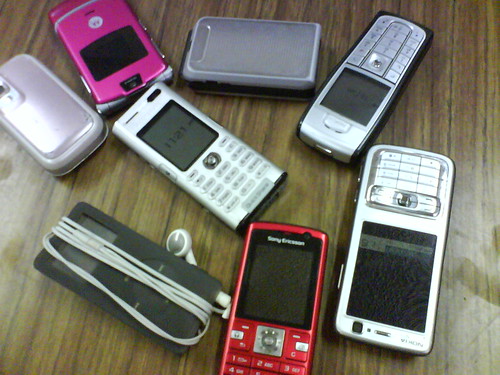 Feel like letting your imagination run wild for a moment?
Feel like letting your imagination run wild for a moment?
Imagine what sort of class projects you could attempt if every student in your class had access to their very own digital camera that they carried with them at all times? Or what about if every student in your class had their own personal video camera? Or perhaps a Global Positioning System? Or a podcast player? Or voice recorder? Or mobile Internet device? Or messaging system? Or classroom voting system? What if, instead of having to wait their turn to use these tools, students had access to their very own device which could do all of these things?
What sort of interesting projects could you come up with if each student had a small, lightweight device that did all (or even some) of these things? A device that fit into a pocket and could be carried anywhere, ready to whip out to snap a photo or record a video or audio grab? Something that could identify the coordinates of their global position, or allow them to quickly check a fact in Wikipedia? Imagine the sorts of multimedia extravaganzas your students could produce if they carried such a device with them on an excursion or field trip, enabling them to record their experiences for later use in a class report? Imagine how much more interesting their lab reports would be if students could make videos of their science experiments. Or record their voice as they summarised the novel they were reading, ready for inclusion in a podcast. Or collect survey data from their family and friends by setting up real-time surveys to gather opinions. Some interesting possibilities?
Of course, the cost of providing such a device to every student would be outrageously expensive. There is no way that most schools could afford to give every student a camera, a voice recorder, or a GPS, much less provide them with a single device that did all of these things.
Here’s the surprise. Schools don’t need to supply such devices. The fact is, there are rapidly growing numbers of students at your school right now that already own such a device.
It’s called a mobile phone.
The modern mobile phone is a remarkable piece of technology. Even a fairly run-of-the-mill mobile phone can now do most, if not all of the things mentioned above. Many mobile phone providers will provide one of these highly sophisticated handsets, even on their most basic plans. The upshot of all this is that there are many, many students in your schools right now that carry these amazing little multimedia devices in their pockets, and their numbers are growing. They could be used for the scenarios suggested above, and many more as well. They could empower students to gather multimedia clips, document their work and have on-demand access to a plethora of digital resources. They could engage student interest and help reinvent the way we approach learning.
And what do most schools do? We ban them of course.
What is it about mobile devices that seems to strike fear into the hearts of so many school administrators? Perhaps it is the logistical nightmare of dealing with issues like potential theft or damage? Perhaps it is the lack of control over what students might access online as they use their 3G phones to completely bypass school internet filters and go directly to the content that interests them. Perhaps it is paranoia about the potential problems that could occur if students were able to capture school events on video. A quick browse through YouTube can certainly find all sorts of embarrassing teacher behaviours, captured on a phone in class and posted online for all the world to see. Certainly, there are issues to deal with, but to turn a blind eye to the possibilities that these powerful little tools bring to student learning would be to miss some wonderful opportunities.
Even the most basic mobile phone can be used for something as useful as voting via SMS text messaging. Using a free service such as SMS Poll, teachers or students can set up a multiple option survey question that users then vote on by sending a single text message to a nominated number. The site automatically gathers and collates the responses and the results appear on a webpage immediately, nicely graphed to display a summary of voter responses. Powerful tool for learning? You bet.
Who makes the most digital cameras? Nikon? Canon? Kodak? In fact, none of these leading camera makers are the world’s largest producer of digital cameras… that title now goes to Swedish cellphone manufacturer Nokia. It’s virtually impossible now to buy a mobile phone that does not contain a digital camera, and the quality of the images produced by these devices might surprise you. Some quite basic phones shoot at resolutions up to 8 Megapixels, and some even have flashes for shooting in semi-dark locations. And, even a modest mobile phone can snap hundreds of images, ready for transferring to a computer via cable or Bluetooth, with some 3G phones even able to upload them directly to online services such as Flickr. The time between taking a shot and sharing it with the world can quite literally be seconds. What if every student on that excursion to the zoo took dozens of photos as they wandered around, ready to remix them into a digital presentation back at school using tools like Photostory, iMovie or Voicethread?
The ability to capture video is also built into many phones these days, and although the quality can be a bit ordinary on some of the cheaper phones, there are more and more hansdets being released with some pretty impressive video capabilities. Some can now shoot footage that rivals the quality of standard DV camcorders, that can be easily transferred to a computer for editing in iMovie or Windows Movie Maker. Whip your phone out during that science experiment and you have a neat clip ready to drop into your lab report. Rather that submit a word processed report, what if students used a free tool like Shozu (www.shozu.com) to send that footage directly to an online video hosting service, where it could then be embedded into a wiki and shared with the world. Imagine how much more authentic these tasks would be if student projects were published to the world rather than handed-in to a teacher. Having a mobile phone in your students’ pockets can be the starting point for many such opportunities.
While not every mobile phone has the ability to operate as a Global Positioning System, a surprising number do. Even if only a handful of your students had a GPS-enabled phone, what if they worked in teams to participate in geocaching projects, like the many thousands of such projects available for free on websites like www.geocaching.com. Beyond that, what if they used their phone’s GPS capabilities to create their own geocaching projects? Think of the learning that would take place as they mapped coordinates, created clever clues and published their challenges to the rest of the world.
Even fairly basic phones come with a built-in voice recorder. Some can only record in short bursts, say 60 seconds at a time, and others can record for hours, but the ability to make an audio recording is an incredibly useful capability. Using the built in microphone to conduct interviews, students can then transfer those audio grabs to a computer and the recordings can then be assembled into a podcast using free software such as Audacity. Most phones can also be used to play back audio files, so these finished podcasts can then be loaded back onto the phone to be listened to. Students could produce a podcast about, say, the novel they are studying, the music piece they are learning, the speech they are planning to give next week or the study notes for next week’s exam, and listen to it on the bus going home from school, enabling real anywhere, anytime learning.
The way that mobile service providers currently charge for data plans, it’s true that not every student is likely to have access to the mobile web via a 3G service right now. However, a surprising number do, and with the price of 3G access dropping all the time, don’t be too surprised if the ability to connect to the mobile web becomes a standard feature of all mobiles within the next couple of years. Thanks to revolutionary advancements such as the iPhone, being able to to connect to the web with a handheld device is quickly becoming an expected feature of all mobile phones. Good luck with those school filters!
There is lots more that can be done with even a moderately capable mobile handset, and the ability to download and install small phone-based applications to your phone is becoming commonplace. Because a modern mobile phone is really a computer in a small package, installing additional software onto it can transform your phone into almost anything you want it to be… a live streaming web cam, a planetarium, a drum machine, a library of guitar chord charts, a mobile client for Second Life or Google Earth, a barcode reader, a tool to navigate Wikipedia, or a way to maintain your Facebook. All in your pocket. This is not science fiction… all this and more is available right now, providing a powerful platform for your students to do some amazing things.
All of this might require us to rethink a few things. As teachers, what sort of questions do we ask a generation of students who now carry Google around in their pocket? What sort of future will we face if we continue to pretend that these powerful devices have no place in our schools? Powerful, portable, personal. Mobile technology is not going away, and the full force of this technological wave has not really hit the shore yet.
Are you ready for it?

 Seems that
Seems that  The things you discover by accident…
The things you discover by accident…